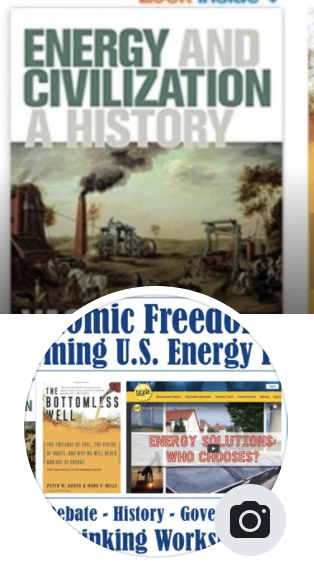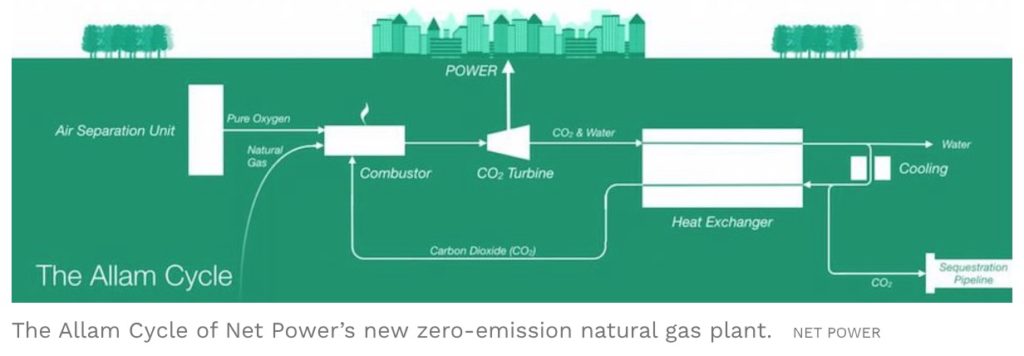Energy Race Update…
With much of middle America frozen, it’s worth reflecting in energy policy, last year’s NCFCA policy debate topic. Below is update of 2019 post on The Energy Race. (Also this 2018 Energy Race post on MasterResource.org.)

Earlier Economic Thinking Energy posts here and shared posts on Facebook ET Energy page.
Technologies compete and advance, grocery bags, for example. Paper bags get better as do plastic bags and reusable bags. Building materials from wood to plastic to concrete advance with innovations. So no surprise that energy generating technologies similarly advance and innovate. Solar panels get more efficient and less expensive. Windmills get larger, stronger, and generate more electricity. Natural gas power plants get smaller and more efficiency. Nuclear energy is getting smaller too, with many new technologies in development.
Market economies coordinate thousands of people and firms who cooperate and compete in the design and fabrication of energy-generating products and services. Company research and development advances quality, reliability, and efficiency. Market cooperation and competition advance knowledge and technologies, says Robert Bryce to be Smaller, Faster, Lighter, Denser, Cheaper.
So windmills throw off more power on windy days, and solar panels more energy on sunny days. Hydropower and natural gas combined cycle power plants continue to advance. Net Zero natural gas technology burns oxygen instead of air to general power without any CO2 emissions to the atmosphere. Technology advances turn coal plants cleaner and greener, some injecting CO2 underground: see Chevron starts its unique project that buries carbon dioxide underground (Quartz, August 10, 2019), and an earlier U.S. story: The world’s largest carbon-capture power station will soon open—on schedule and within budget (Quartz, October 5, 2016) [Update: ExxonMobile abandoned their similar project according to paywalled 2020 Dallas News headline.]
It’s an energy race! Teams of companies and technologies improve wind, solar, hydro, gas, coal, and nuclear, making advances month by month (though with some setbacks). Policy debaters and consumers want the best technology to prosper: to deliver cleaner, less-expensive, and more reliable heating and electricity.
Geekwire profiled TerraPower, the nuclear energy technology Bill Gates is developing: Inside the lab where Bill Gates’ TerraPower is inventing the future of nuclear energy (Geekwire, August 11, 2019). Other companies are working to bring nuclear power to the modern age, updating technologies that are decades old.
Thorium power is among the nuclear energies racing to replace proliferating coal power around the world. Is Thorium the Fuel of the Future to Revitalize Nuclear? (Power Engineering, August 13, 2019):
If thorium becomes popular, costs will only decrease as thorium is widely available anywhere in the earth’s crust. Thorium is found in a concentration over 500 times greater than fissile uranium-235. Historically, thorium was tossed aside as a byproduct of rare-earth metal mining. With extraction, enough thorium could be obtained to power LFTRs for thousands of years. For a 1 GW facility, material cost for fuel would be around $5 million. Since LFTRs use thorium in its natural state, no expensive fuel enrichment processes or fabrication for solid fuel rods are required, meaning the fuel costs are significantly lower than a comparable solid-fuel reactor.
Thorium power has advocates and detractors. Should Australia consider thorium nuclear power? (The Conversation, March 1, 2015) notes:
The call for thorium power is not without precedent worldwide. India has pursued thorium technology for decades. And China is revisiting a molten salt reactor design mothballed by the USA in the 70’s. Recently, several companies have sought to commercialise thorium energy, including an Australian-Czech alliance.
Thorcon floating supertanker molten salt reactors starting with 2021 prototype (NextBigFuture, December 6, 2017) looks at a leading Thorium power company. Lars Jorgensen outlines the advantages and opportunities for Thorium energy in ThorCon: Cheap, Reliable, CO2-Free Electricity by Lars Jorgensen @ ThEC2018.
Other Thorium companies compete with Thorcon, and various nuclear startups compete with tradition nuclear power. (Thorium power advocates note that U.S. regulations developed for traditional nuclear power are ill-suited for regulating thorium power.)
Plus Bill Gates and others are investing in fusion power: In search of clean energy, investments in nuclear-fusion startups are heating up (Quartz, September 26, 2018). Other billionaires are pouring money into fusion power research and development: Billionaires Chase ‘SpaceX Moment’ for the Holy Grail of Energy (Bloomberg, October 29, 2018)
Other startup companies are developing “desktop” nuclear. Announcing 1517 Fund Investment: Zeno Power Systems (Medium, The Subversionist, July 31, 2019):
Zeno provides a clean, safe, and sustainable energy source for institutions that rely on that energy and currently have to use subpar alternatives. The team currently focuses on use-cases for a tabletop-sized energy cell for schools, hospitals, and remote locations.
Props aren’t allowed in debate, otherwise bringing a desktop nuclear device to a round might make a powerful impression with judges.

This post started with the energy technology race, devising new technologies for energy production, distribution, and use. Better, cheaper electricity sources combine with ever more efficient devices–including electric cars and planes.
See, for example, Fly Electric: The Aircraft of the Future Takes Flight (The Atlantic, part of a sponsored Ten Predictions for 2025 feature). More electric airplane stories: The Future of Flight: The next electric vehicle is the airplane (Mashable) And maybe hybrid engines will come first: Could Hybrid Electric Planes Fly Commercial? Airbus And SAS Aim To Find Out, (Forbes, May 29, 2019)
The original post’s Energy Race title included: “though racing in different directions.” Less expensive and more reliable energy is a goal, but not the only goal (or constraint). Cleaner energy sources is as important as reducing costs and improving reliability. Pollution is a cost, though one avoided by producers and consumers (and harmful particles and other emissions cause health problems. And carbon dioxide emissions are a separate emission issue, beneficial for plants but contributing to concerns about climate-change. Energy from wind, solar, nuclear, and hydro avoid pollution and CO2 emissions, but have other trade-offs.
One of the fastest competitors in the new energy race is natural gas. Gas supplies have boomed in recent years and prices dropped as hydraulic fracturing technology advances have expanded supply. Natural gas is the cleanest of the fossil fuels, emits the least CO2, and combined cycle natural gas power plants are astonishing energy efficient. (GE says they have the efficiency record at 62.22%: BREAKING THE POWER PLANT EFFICIENCY RECORD (GE)).
This most efficient gas power plant still emits CO2, which presents a challenge in the race against wind, solar, hydro, and nuclear power. As mentioned above, new processes and technologies allow natural gas to enter the zero emitted CO2 race: Net Zero Natural Gas Plant — The Game Changer (Forbes, July 31, 2019). In the “game” (or race) to zero CO2 emissions, using pure oxygen instead of CO2 is the innovation:
The process involves burning fossil fuel with oxygen instead of air to generate electricity without emitting any carbon dioxide (CO2). Not using air also avoids generating NOx, the main atmospheric and health contaminant emitted from gas plants. …
All CO2 that is generated by the cycle is produced as a high-pressure, pipeline-ready by-product for use in enhanced oil recovery and industrial processes, or that can be sequestered underground in tight geologic formations where it will not get out to the atmosphere for millions of years.

So maybe this new Net Power natural gas technology will be a strong (and more reliable) competitor to wind and solar power. But less CO2 emissions isn’t a good thing for all Earth’s creatures. Beyond being the curse of climate change models, carbon dioxide is food for plants. Global greening from increased carbon dioxide fertilization.
A 2021 story NET Power CEO Announces Four New Zero-Emission Gas Plants Underway (Forbes, January 8 2021) notes:
Where there is no carbon price, he said, a NET Power plant will become competitive, through economies of scale, after 30 plants have been built, he said, but the sale of the products it produces can make it competitive immediately.
Matt Ridley, writing in Die Weltwoche, argues Global greening is happening faster than climate change, and it’s a good thing (excerpted in WUWT, July 5, 2019). Carl Zimmer in The New York Times, makes the case that ‘Global Greening’ Sounds Good. In the Long Run, It’s Terrible (NYT, July 30, 2018):
Elliott Campbell, an environmental scientist at the University of California, Santa Cruz, and his colleagues last year published a study that put a number to it. Their conclusion: plants are now converting 31 percent more carbon dioxide into organic matter than they were before the Industrial Revolution.
So while the debate continues over carbon dioxide emissions are good or bad, the technology race across wind, solar, hydro, nuclear, coal, oil, and natural gas technologies continues. When and if politicians and state bureaucracies decide where the race should be headed, firms will innovate and compete to get there.
In the shorter term, some energy decisions should be made quickly. For Texas NCFCA debaters, it’s worth figuring out energy spikes and blackout threats in state with vast energy resources. See, for example: On the Brink of Blackouts, Texas Makes Case for New Plants ” (Yahoo Finance, August 14, 2019). (And of course, blackout concerns became a reality in Texas this month, February, 2021.)
…And winds weren’t strong enough to rescue the region earlier this week as Dallas baked in 103-degree Fahrenheit (39-degree Celsius) weather. Generation from turbines has plunged for three straight days….
Meanwhile, in the last six months of 2018, three gas-fueled projects and five wind projects were canceled. Another 2,485 megawatts of gas, wind and solar projects were delayed, …
The grid operator warned of power shortages on Tuesday. For the first time since January 2014, it declared an energy emergency, calling on all power plants to ramp up and asking customers to conserve. At one point on Tuesday afternoon, the region’s power reserves had dwindled to a record 2,121 megawatts, less than 3% of total demand on the system.
For more on the February 2021 Texas blackouts, see Wind Subsidies Help Freeze Texans (MasterResource, February 18, 2021), Assigning Blame for the Blackouts in Texas (Climate, Etc./JudithCurry.com), Understanding the Texas Energy Predicament (Institute for Energy Research, February 18, 2021), Severe power cuts in Texas highlight energy security risks related to extreme weather events (IEA, February 18, 2021).

